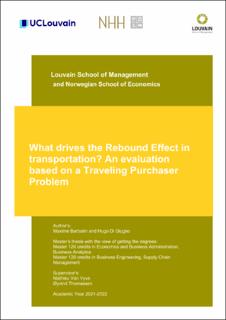| dc.description.abstract | Limiting climate change is one of the most important challenges of the 21st century.
Focusing on the transport sector, encouraging the use of more energy-efficient transport
modes, and improving the performance of vehicles are the main targets in the fight for
GHG reductions. However, due to Rebound Effect (RE), it is proven that improvements
in engine fuel efficiency result in lower cost per kilometer driven and can induce individuals
to use vehicles more often or to drive longer distances. As a result, the potential energy
savings from improved energy efficiency could be partially or totally offset. Therefore, we
decided to examine "What drives the Rebound Effect in transportation".
To answer this research question, a Traveling Purchaser Problem was evaluated. This
simple real-life business application models a situation in which a company owns one or
several vehicles and has to buy specific products. The goal is to select and visit a subset
of suppliers to satisfy a given demand for each product while minimizing both purchasing
and travel costs. In total, 510 instances of this problem with various characteristics
and parameters were generated and solved using the optimization software AIMMS. The
impact of five main experimentations was deeply investigated. In addition, the trends
obtained from these experiments were confirmed by fitting a logistic regression and a
decision tree.
The results of the various experiments showed that four variables can influence the occurrence
of RE in a transportation network. On the one hand, RE tended to increase
with the number of potential suppliers from which the firm can choose and the number
of vehicles that the company owns to procure the products. On the other hand, the exclusivity
of the products to source, as well as the introduction of a distance-traveled tax,
reduced the occurrence of RE. To sum up, significant conclusions could be drawn from
the experiments and the results can be easily transferred to real-life business applications.
Recommendations for possible future studies were also discussed. | en_US |
